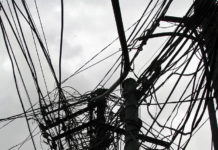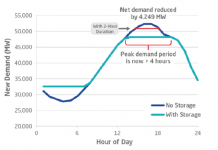Last week, Charles told us to expect wind power industry suppliers to benefit from shortages in wind turbine components. Owens Corning (NYSE:OC) which I mentioned in my Blue Chip Alternative Energy Portfolio fits nicely into this category with their composites for turbine blades, as do the power converter stocks I mentioned two weeks ago. As essential to wind power as any of these is improved power transmission. The National Wind Coordinating Collaborative states, Electrical transmission facilities connecting windy areas and load centers are sometimes non-existent or minimal. Even in cases where a good wind resource has nearby transmission, that transmission often has limited capacity to transport additional energy. In fact, transmission facilities throughout much of the country are strained, and this problem is acute at specific points of congestion. The expansion of wind power is hampered by this situation, but the associated problem is not confined to wind. Instead, it is a general problem of concern to many in the electric power sector. While the need for long distance transmission often holds up the construction of wind farms for logistical reasons (there is no incentive to erect wind turbines if you cannot get the power to market), it is unlikely to prevent investment in renewables for financial reasons. The ERCOT Competitive Renewable Energy Zones Study found that the necessary investment in transmission for the high resource zones they identified in Texas ranged from a low of 1.5% to about 12% of the cost of the generation, which will only change the overall economics of any project in marginal cases. Some of these transmission improvements will also be likely to improve system reliability, and so the full cost is unlikely to be considered totally attributable to the wind projects. As a less expensive but unavoidable investment for new renewable energy projects, transmission improvements are well positioned to be profitable investments in our energy infrastructure as the US shifts to more sustainable electrical supplies. The FERC opens up Transmission Politicians and regulators are beginning recognize the necessity of new transmission. This started with the Energy Policy Act of 1992 (EPAct), which opened access to the transmission grid to allow power to be delivered from one generator to another utility. The Federal Energy Regulatory Commission (FERC) Order 888 laid out laid out the terms under which this was implemented. Order 888 fell short of providing the necessary incentives for investment in transmission and access for renewables, and in December of 2000, the FERC issued order 2000 and 2000-A which require transmission-owning companies under FERC’s jurisdiction to file either proposals to form Regional Transmission Organizations (RTOs) or progress reports on the development of RTO proposals. RTOs will have sole responsibility for operation and expansion of the transmission system, maintaining short-term reliability, establishing and managing tariffs, and responding to requests for service. The credible threat of RTOs in competitive bidding for projects acts as an incentive for utilities to stop delaying necessary investment in transmission, and make such investments quickly at the lowest possible costs. This should benefit investors in the companies best able to build transmission efficiently and quickly. Action at the State Level My own Governor, Bill Ritter recently signed Colorado Senate Bill 100, which requires electric utilities subject to rate regulation to identify high-potential wind-energy locations by undertaking biennial reviews to designate “Energy Resource Zones��? where transmission constraints hinder the delivery of electricity. Texas passed a similar law in 2005, and, as a result, there are several competing proposals for transmission to bring wind power from Texas’ remote, windy areas to where it is needed, such as the proposed "Panhandle Loop". Transmission is not only necessary for large scale wind installation, it also goes a long way (pun intended) towards dealing with wind power’s most oft-cited drawback: the wind seldom blows when you need it. Typically, the wind blows at night, and the overall capacity factor for most wind turbines is around 30%. But long distance transmission allows wind from different areas to be combined, allowing benefits similar to the diversification that we investment advisors are always pushing for our client’s portfolios. The more wind farms that are built over a wider geographical location, the more reliable wind energy is, and it is transmission that ties it all together. In the Great Plains, wind typically blows at night in the winter… but winter peak load in California is typically in the evening: due to the time difference, midwest winter wind is on-peak; a more robust transmission system will bring the power from where and when it is cheap to where and when it is needed. Minnesota has also passed enabling legislation to study and develop plans for transmission network enhancement to support Renewable Energy Standards. In the United States, the grid is characterized by decades of under-investment, with the established operators having insufficient incentives to invest, and as a consequence, having until recently rested on their laurels, treating their existing transmission assets as a sinecure. Therefore, I expect the best investments to be those transmission owners who have shown the ability to upgrade their networks quickly and effectively, with the rest likely to lose out to upstart RTOs which will increasingly be able to win projects from incumbent utilities. There will also be a political aspect to these potential returns: states still have fairly broad authority to implement FERC rules, and the actions of state legislators in utilities commissions will undoubtedly have significant impacts on the decisions and profitability of building new transmission. States which seem particularly supportive of new transmission include the perennial leader, California, along with New Mexico, and the states mentioned above. Ohio, Virginia and Washington are have long been leaders. The Best Companies I see three distinct ways to invest in the coming transmission building boom. We can invest in owners who have shown a willingness and ability to invest effectively in transmission; we can invest in the contractors who do the actual building of new transmission, or we can invest in suppliers of pieces of the transmission puzzle. Among owners, the undisputed US leader is ITC Holdings Corp. (NYSE: ITC). ITC was created three years ago when DTE Energy decided to spin off their transmission assets (2600 miles of lines.) ITC CEO Joseph Welch has run the company since, and has since acquired the transmission properties of Michigan Electric (6800 miles), and is expected to close a deal for 6800 miles of lines from Intrastate Power and Light late this year. Welch recognizes that ITC’s assets have suffered from over two decades of neglect, and expects to spend in excess of $1 billion in upgrades over the next 5 to six years. Given that transmission qualifies for a regulated rate of return, a high rate of investment is a good thing in a transmission organization. ITC seems committed to acquiring more assets and upgrading what it has, which I believe will be good for investors. It’s current territory (in Michigan, Iowa, and Minnesota) also has lots of potential for wind development, which creates the need for even more transmission development. I’d love to see the acquire or develop assets in northern Illinois and Indiana to tie the system together and connect windy Iowa with power-hungry Chicago. The downside: ITC is up 50% since the Michigan Electric deal last summer. In situations like this, I usually sell put options to generate income if the stock does not pull back, or to pick the company up on the cheap if it does. The company known for their ability to build new transmission rapidly and inexpensively is InfraSource Services (NYSE: IFS). It has recently agreed to be acquired by Quanta Services Inc. (NYSE: PWR) in an all-stock transaction. Given that both companies are up over 80% since last summer, and acquiring companies often have earnings hiccups as they struggle to integrate the acquisition, most investors would probably do well to wait for a pullback, and buy stock in the merged company after a disappointing earnings report or two. Among suppliers, I like bulletin board traded Composite Technology Corp (OTC BB: CPTC), which is also up about 90% since last summer, but that is less worrying to me in a microcap company… that sort of volatility comes with the territory. CTC makes an Aluminum Conductor Composite Core cable which they claim can double the current carrying capacity of existing lines, or significantly lower costs for new lines. As a bonus for renewable energy investors, their DeWind subsidiary also manufactures support structures for wind turbines. They recently announced their first contract to supply turbines to XRG in Minnesota. A larger cable supplier is General Cable Corp (NYSE:BGC) which sells not only high voltage cable for electricity transmission as well as telecommunication applications. It has had a similar run-up in the stock price and trades at a rather high multiple for an industrial business. [UPDATE: I said that DeWind “manufactures support structures for wind turbines.” This is not strictly true, and it’s a lot more complex than that… see comments.] Conclusion All in all, an investor looking to get into transmission today is confronted by rather high multiples for industrial businesses. Given the good potential growth in the industry, these companies may not turn out to be overvalued, even at current prices, but I prefer to wait for a pull-back on most of them. For those concerned about missing a continued rise, I would advise putting in only a fraction of the amount you hope to invest now, and slowly buying more whenever one of the stock pulls back to a level you are more comfortable with (or using my naked puts strategy, if you understand the risks involved with options and can get sufficient options trading approval from your broker.) DISCLOSURE: Tom Konrad and/or his clients have positions in the following stocks mentioned here: CPTC.OB. DISCLAIMER: The information and trades provided here are for informational purposes only and are not a solicitation to buy or sell any of these securities. Investing involves substantial risk and you should evaluate your own risk levels before you make any investment. Past results are not an indication of future performance. Please take the time to read the full disclaimer here. Thanks to Lynn Greene for her help with the research for this article.









Huh?? CPTC, as far as their prospectus goes, and as far as I know, is a virtual manufacturer, (Westinghouse being the contractor), of 2 meg turbines, not their support structures.
Calvino, I believe you are right about the actual turbines, but the support structures for those turbines are another matter: http://www.compositetechcorp.com/windpower.htm.
Yes, much of the dollar value of those contracts is going to Westinghouse, but for a tiny company like CPTC, any fraction is a nice boost to the bottom line.
According to another reader and long-term investor in CPTC, DeWind makes the nacelles (turbine body), and outsources the support structure [which does not totally contradict the website, which says they “applied [their] proprietary composite technology to the development of innovative wind turbine support structures.” Clearly they have been changing their business model for the DeWind unit rapidly.
DeWind wind turbines will be manufactured by TECO Westinghouse in Texas for DeWind Energy, which is a subsidiary of CTC Corp. This is clearly stated on the CTC website and in their PRs.
How about Beacon power – Grid Freq support ?
Thanks, just info for the future of transmissions.
I do like BCON (and own some)… I have an idea for an unwritten article about grid frequency report… it will be essential as the grid moves towards more distributed generation. — TK